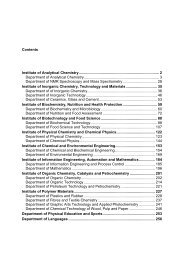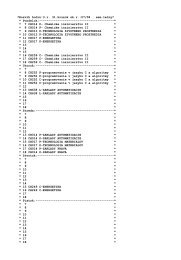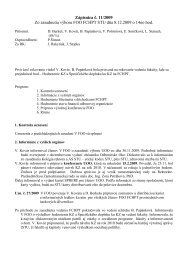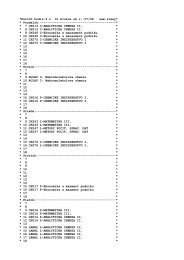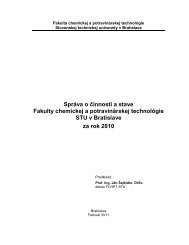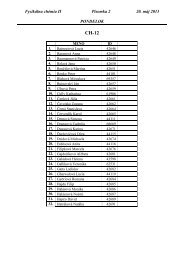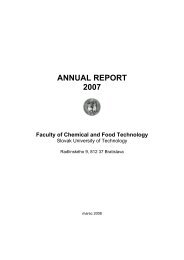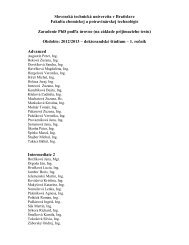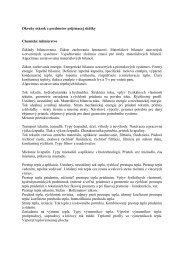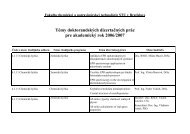rok 2006 - Fakulta chemickej a potravinárskej technológie ...
rok 2006 - Fakulta chemickej a potravinárskej technológie ...
rok 2006 - Fakulta chemickej a potravinárskej technológie ...
You also want an ePaper? Increase the reach of your titles
YUMPU automatically turns print PDFs into web optimized ePapers that Google loves.
IV. CURRENT RESEARCH PROJECTS<br />
VEGA Project No 1/2109/05 The Use of the Pulse Technique on the Preparation of the<br />
Composite and Alloy Layers on the Metal Substrates (Marta Chovancová)<br />
Ni – W alloy coatings were deposited from aqueous electrolytes by direct current and pulse current under<br />
various current densities and different pulse ratios and pulse cycles. In the case of direct current the content of<br />
the tungsten in Ni – W alloy increased with current density and for the pulse deposition the tungsten is deposited<br />
in the major part at the higher current densities as well. The deposits obtained by direct and pulse current are<br />
homogenous and their surface is fine-grained without segmentation. The corrosion resistance of Ni – W alloys<br />
has been investigated before and after thermal treatments. Corrosion resistance of annealed alloy deposits is<br />
higher in comparison to the only electroplated ones.<br />
The composite coatings with the nickel matrix and polytetrafluoroethylene dispersed particles TF 5033<br />
were prepared with high reproducibility. The adhesion and microhardness of the composite coatings depends on<br />
the used substrates (carbon steel and stainless steel). The scanning electron microscopy photographs of Ni-<br />
PTFE composites showed the PTFE layer covering the deposited metal grains.<br />
The influence of the used electrolyte type for electrolytic colouring of anodised aluminium was investigated.<br />
Anodic oxidation of aluminium was realised in sulphuric acid electrolyte and electrolytic colouring on the nickel<br />
(Ni) basis. The stress was put on colouring electrolyte with and without complexing agent. Ni was deposited by<br />
alternative current (AC) at precisely defined conditions at constant 50 Hz frequencies. In particular, the waveform<br />
of current was given as a sine wave with variable amplitude superimposed on variable DC component. Also, halfwave<br />
and full-wave rectified current waveforms have been tested. The aim is to reveal the influence of current<br />
waveform shape on the quality of the anodised surface. After dipping of the obtained finishes in the chromium –<br />
phosphoric solution, alumina layer was stripped off and amount of Ni was determined by EDX. Complexing agent<br />
influences the amount of Ni in the finishes and thorough intensity of colouring of the anodised finishes.<br />
Project duration: from January 2005 to December 2007<br />
VEGA Project No 1/2108/05 The Chemical and Electrochemical Reactions of Sulphur Species<br />
at Aluminium Electrolysis (Pavel Fellner)<br />
Sulphur is introduced to the aluminium cell from the graphite anode and from raw materials, fluoride salts and<br />
secondary alumina (alumina from dry scrubbers). Aim of the project is to investigate the chemical and<br />
electrochemical reactions of sulphur species at aluminium electrolysis.<br />
I. In the first period of the project, the adsorption of SO 2 on alumina will be investigated. Equilibrium adsorption<br />
data will be obtained for different pressures of SO 2 and temperatures. From the analysis of this data the nature of<br />
the interaction between alumina and SO 2 will be established.<br />
Sulphur is introduced to the cell in the form of sulphates. The chemical and electrochemical reduction of sulphates<br />
in the conditions met in the aluminium cell will be investigated. Carbon and aluminium dissolved in cryolite melt<br />
will be used as reducing agents.<br />
The electrochemical reactions of sulphates will be investigated as well. Cyclic voltametry and<br />
chronopotenciometry will be used. Mechanism and kinetics of these reaction will be determined.<br />
II. Behavior of sulphates at an inert (platinum) and graphite electrode will be studied. When an inert electrode is<br />
used the anodic product is oxygen and sulphur oxides. Mechanism and kinetics of this reaction will be studied.<br />
When graphite anode containing sulphur (thiophene) is used, COS originates as one of the anode products.<br />
Mechanism and kinetics of this process will be studied.<br />
Project duration: from January 2005 to December 2007<br />
State Project E 02.02.01 Concept of Twosteps Transmutation (Pavel Fellner)<br />
Investigation and critical analysis of phase equilibria and electrochemical properties of the lanthanide and actinide<br />
fluorides, electrodeposition of lanthanum.<br />
Project duration: from October 2003 to December <strong>2006</strong><br />
VEGA Project No 1/2476/05 Ferrates– Thermodynamics and Kinetics of Chemical and<br />
Electrochemical Reactions in Molten Electrolyte and on the Phase Boundary Electrode -<br />
Electrolyte (Ján Híveš)<br />
Many problems are associated with previously known synthesis of Fe(VI) salts. The common problems<br />
encountered are low yield rate, Fe(VI) chemical instability, and the toxicity of the by-products produced during<br />
synthesis. A novel approach is needed to produce Fe(VI) product in a large quantity for use in full-scale water<br />
38



